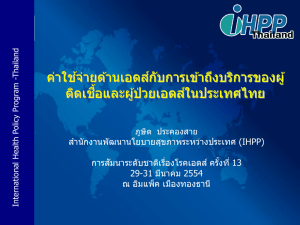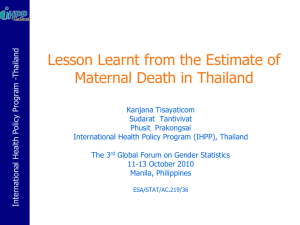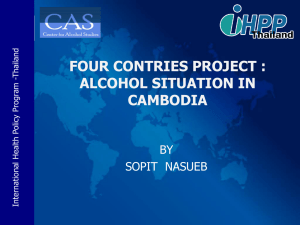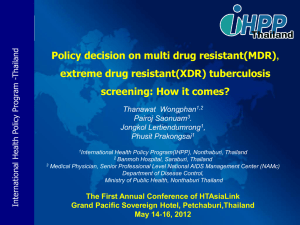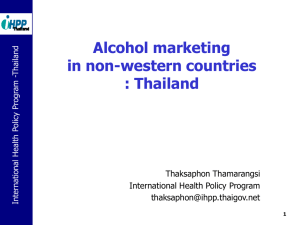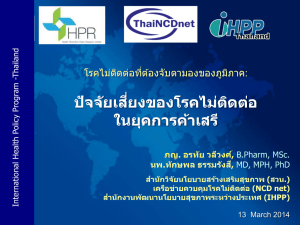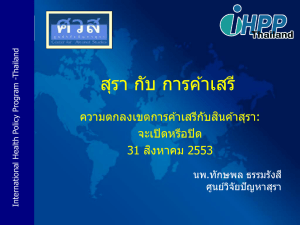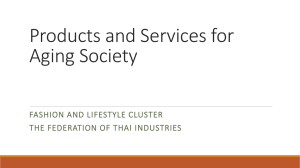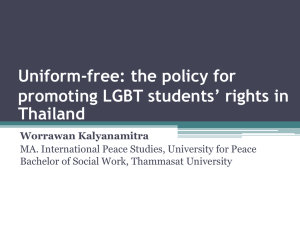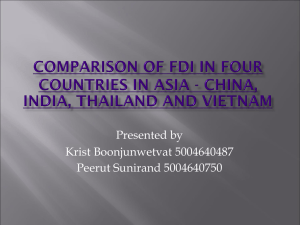Liturature Review of CVA (stroke) in Thailand
advertisement
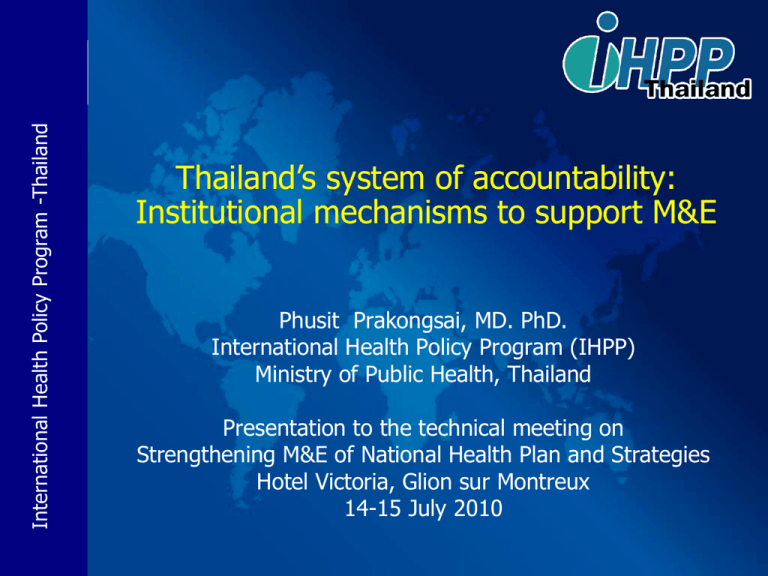
-Thailand Program Health Policy International -Thailand Program Policy Health International Thailand’s system of accountability: Institutional mechanisms to support M&E Phusit Prakongsai, MD. PhD. International Health Policy Program (IHPP) Ministry of Public Health, Thailand Presentation to the technical meeting on Strengthening M&E of National Health Plan and Strategies Hotel Victoria, Glion sur Montreux 14-15 July 2010 Program Health Policy International -Thailand Program Policy Health International -Thailand HIS for M&E in Thailand • The HIS in Thailand is not a single system, but it consists of multiple sub-systems of health information with involvement of many key stakeholders in and outside the health sector: – Vital registration from Ministry of Interior (MOI); – Community-based household surveys from National Statistical Office (NSO), MOPH, research institutes; – Facility-based data from several Departments of MOPH, National Health Security Office (NHSO), CGD; – Disease surveillance from Department of Disease Control of MOPH; – NHA and DRGs data from research institutes –IHPP, CHEM, etc. • Main financing sources for HIS – Regular government budget, – 2% earmarked tax fund from tobacco and alcohol consumption through Thai Health Promotion Foundation, – Direct payments from data users, either public or private organizations. 2 Monitoring & Evaluation of health systems reform /strengthening A general framework Inputs & processes Financing Indicator domains Governance Infrastructure / ICT Health workforce Supply chain Information Data sources Administrative sources Financial tracking system; NHA Databases and records: HR, infrastructure, medicines etc. Policy data Outputs Outcomes Impact Intervention access & services readiness Coverage of interventions Improved health outcomes & equity Prevalence risk behaviours & factors Social and financial risk protection Intervention quality, safety and efficiency Responsiveness Facility assessments Population-based surveys Coverage, health status, equity, risk protection, responsiveness Clinical reporting systems Service readiness, quality, coverage, health status Vital registration Analysis & synthesis Communication & use Data quality assessment; Estimates and projections; In-depth studies; Use of research results; Assessment of progress and performance of health systems Targeted and comprehensive reporting; Regular country review processes; Global reporting Data availability for M&E system in Thailand (1) Input HCF HR H Infra struct ure Gov er nan ce Output Med/ Healt h tech HIS acc ess qual ity safe ty Outcome effic ienc y Interve n coverag e Impact Risk factor s Biennial HWS Census / SPC Equit y Finan prote ct ion MICS Reproductive H survey NHES NHA Re sp on siv e Civil registration and vital statistics Biennial SES H outco me Note: SES = household socio-economic survey, HWS= Health and Welfare survey, NHES = National Health Examination survey, MICS = Multiple Indicator Cluster survey, NHA = National Health Accounts, HA = Hospital accreditation, SPC= Survey of Population Changes Data availability for M&E system in Thailand (2) Input HC F Facility-based report H resource survey HRH Infra structu re Gove r nanc e Output Med/ Health tech HIS acc ess Outcome quali ty safet y effici ency Interven coverage Impact Risk factors Res pon sive Equity HIS electronic IP database Dis surveillance Behavioral H survey Sero-sentinel Survey Specific dis registration Quality assurance (HA) H outco me Finan protect ion Program Health Policy International -Thailand Program Policy Health International -Thailand Case study on assessing the impact of achieving universal coverage (UC) in 2002 • Key characteristics of the UC policy in Thailand – Introducing a tax-funded health insurance schemes to cover 47 million (or 75%) of population who were neither civil servant and social health insurance (SHI) beneficiaries, – Promote the use of primary care as the main contractor and gate keepers, – Changing resource allocation from historical basis to capitation contracting model and performance-based payments, – Removal of financial barriers to health services. • Five key questions on assessing the impact of the UC policy – – – – – Financial risk protection from catastrophic health expenditure, Equity in access to and utilization of health services, Who benefits from government subsidies for health? Who pays for health care? Financial sustainability of the government health budget 6 Program Health Policy International -Thailand Program Policy Health International -Thailand Scheme beneficiaries by income quintiles, 2004 100% 80% 10% 17% 49% 52% 23% 60% 40% 20% 0% 26% 31% 25% 11% 7% 4% 14% 25% 5% 1% SSS UC CSMBS Q1 (poorest) Q2 Q3 Q4 Q5 (the richest) Source: Analysis from the 2004 Household Health and Welfare Survey (HWS) conducted by NSO. 8 6 5 % household Program Health Policy International -Thailand Program Policy Health International -Thailand Declining of catastrophic health expenditure from 2000 to 2006 4 3 2 1 0 2000 2002 Quintile 1 2004 Quintile 5 2006 All Source: Socio-Economic Survey 2000 - 2006 conducted by NSO. Note: Catastrophic health expenditure refers to household out-of-pocket payments exceeding 10% of household income 9 Improved fairness of financial contributions Out of pocket payments, 1992-2006 % income spent on health 8 1992 1994 1996 1998 2000 2002 2004 2006 7 6 5 4 3 2 1 10 ile 9 D ec ile 8 D ec ile 7 D ec ile 6 D ec ile 5 D ec ile 4 D ec ile 3 D ec ile 2 D ec ile D ec ile 1 0 D ec Declining of gap 9 Income Deciles Source: Household Socio-Economic Survey 1992 - 2006 conducted by NSO. 10 Program Health Policy International -Thailand Program Policy Health International -Thailand Equity in health care finance: Financial Incidence Analysis • Subsequent studies indicate the Concentration Index of various sources of healthcare finance – Thailand 2002 (O’Donnell et al 2005) CI weight NHA – – – – – – Direct tax Indirect tax Social insurance Private insurance Direct payments Total Health Financing – General Tax 0.9057 0.5776 0.5760 0.3995 0.4864 0.5929 0.1868 0.3155 0.0582 0.0668 0.3728 0.6996 Note: CI, an index of the distribution of payments, ranges (-1 to 1), a positive (negative) value indicates the rich (poor) contributes a larger share than the poor (rich), a value of zero is everyone pays the same irrespective of ability to pay 11 Program Health Policy International -Thailand Program Policy Health International -Thailand Equity in utilization: Concentration Indexes of OP service by level 2001 to 2007 Facility levels 2001 2003 2004 2005 2006 2007 Health centers -0.294 -0.365 -0.345 -0.380 -0.267 -0.292 District hospitals -0.270 -0.320 -0.285 -0.300 -0.256 -0.246 Provincial and regional hospitals -0.037 -0.080 -0.119 -0.100 0.028 0.013 Private hospitals 0.431 0.348 0.389 0.372 0.516 0.528 Overall -0.090 -0.139 -0.163 -0.177 -0.054 -0.041 Note: CI range from -1 to + 1. Minus 1 (plus 1 ) means in favour of the poor (rich), or the poor (rich) disproportionately use more services than the rich (poor). 12 -Thailand Program Health Policy International -Thailand Program Policy Health International Equity in health service use: Concentration indexes of IP service by level 2001 to 2007 Types of health facilities 2001 2003 2004 2005 2006 2007 Community hospitals -0.316 -0.293 -0.294 -0.266 -0.242 -0.293 Provincial and regional hospitals -0.069 -0.138 -0.114 -0.156 -0.049 -0.114 Private hospitals 0.320 0.309 0.254 0.366 0.398 0.464 Overall -0.079 -0.121 -0.127 -0.114 -0.051 -0.080 13 Who benefits from government subsidies for health? Benefit incidence analysis (BIA) 2001 and 2003 35 30 31 28 25 22 20 percent Program Health Policy International -Thailand Program Policy Health International -Thailand A comparison of percent distribution of net government health subsidies among different income quintiles in 2001 and 2003 20 17 17 15 15 16 18 15 2001 2003 10 5 0 Q1 Q2 Q3 Q4 Q5 Income quintile Note: -Overall net government health subsidies in 2001 were approximately 58,733 million Baht, and in 2003 were 80,678 million Baht (in 2001-value) - The concentration index of government health subsidies in 2001 was -0.044 and in 2003 was -0.123 14 Program Health Policy International -Thailand Program Policy Health International -Thailand Using evidence to develop appropriate provider payments during the UC era • Increase equitable access by – A separation of payment for high cost services – Developing underserved services: • Excellence centers (trauma, cardiac, cancer, stroke fast tract, STEMI), • EMS, • Community rehabilitation – Expansion of benefit package: universal access to ARV, RRT – Compulsory licensing of high cost drugs: chemotherapy for cancer patients. • Improve quality & effectiveness of services – Disease management program: DM, TB 15 500,000 400,000 300,000 200,000 100,000 0 10,000 8,000 6,000 4,000 20 03 20 04 20 05 20 06 20 07 20 08 Program Health Policy International -Thailand Program Policy Health International -Thailand Increased access to particular services after introduction of appropriate provider payments ALS BLS FR 250,000 200,000 2004 2005 2006 2007 2008 Open heart 60,000 40,000 150,000 100,000 50,000 0 2,000 0 20,000 2004 2005 2006 2007 2008 Chemo 0 2004 2005 2006 2007 2008 Cataract 16 More equitable geographical access to open-heart surgery between 2004-2007 ิ ลำเนำของผู ภูมิลำเนำของผูป้ ่ วยในสิ ทธิ หลักประกันสุขภำพถ้วนหน้ ำ ที่รบั กำรรั ภูมิลกำเนำของผู ษำ ป้ ่ วยในสิ ทธิ หลักประกันสุขภำพถ้วนหน้ ำ ที่รบั ภูกำรรั กษำ ป้ ่ วยในสิ ทธิ หลักประกันสุขภำพถ้วนหน้ ำ ที่รภูบั มกำรรั มิลำเนำของผู กษำ ป้ ่ วยในสิ ทธิ หลักประกันสุขภำพถ้วนหน้ ำ ที่รบั กำรรักษำ โรคหัวใจในโรงพยำบำล Excellence Center ปี 2547 โรคหัวใจในโรงพยำบำล Excellence Center ปี 2548 โรคหัวใจในโรงพยำบำล Excellence Center ปี 2549 โรคหัวใจในโรงพยำบำล Excellence Center ปี 2550 กรุงเทพฯ นนทบุรี ปทุมธำนี นนทบุรี กรุงเทพฯ จันทบุรี กรุงเทพฯ ปทุมธำนี จันทบุรี ชลบุรี Less than 21.06 Less than 21.06 Less than 21.06 Less than 21.06 21.06 – 42.12 21.06 – 42.12 21.06 – 42.12 21.06 – 42.12 42.12 and More 42.12 and More 42.12 and More 42.12 and More หน่ วย : อัตรำต่อ 100,000 ประชำกรสิ ทธิ หลักประกันสุขภำพถ้วนหน้ ำ หน่ วย : อัตรำต่อ 100,000 ประชำกรสิ ทธิ หลักประกันสุขภำพถ้วนหน้ ำ หน่ วย : อัตรำต่อ 100,000 ประชำกรสิ ทธิ หลักประกันสุขภำพถ้วนหน้ ำ หน่ วย : อัตรำต่อ 100,000 ประชำกรสิ ทธิ หลักประกันสุขภำพถ้วนหน้ ำ แหล่งที่มำ : ข้อมูลจำกฐำนข้อมูลผู้ป่วยใน สำนักงำนหลักประกันสุขภำพแห่งแหล่ ชำติ งที่มำ : ข้อมูลจำกฐำนข้อมูลผู้ป่วยใน สำนักงำนหลักประกันสุขภำพแห่ งชำติ แหล่ งที่มำ : ข้อมูลจำกฐำนข้อมูลผู้ป่วยใน สำนักงำนหลักประกันสุขภำพแห่ แหล่งงชำติ ที่มำ : ข้อมูลจำกฐำนข้อมูลผู้ป่วยใน สำนักงำนหลักประกันสุขภำพแห่งชำติ 17 Financial sustainability: Total health expenditure 1994-2005 300,000 4.50% 4.00% 250,000 3.50% 3.00% 2.50% 150,000 2.00% 100,000 %GDP Mil. Baht 200,000 1.50% 1.00% 50,000 0.50% 0 0.00% 1994 1995 1996 1997 1998 1999 2000 2001 2002 2003 2004 2005 public private %GDP Total health expenditures, 2003-2005: 3.55 – 3.49% of GDP, THE per capita approx 100 USD Program Health Policy International -Thailand Program Policy Health International -Thailand Using evidence for decision making on the benefit package of the UC scheme Years Alendronate (million USD) 2009 15.6 2010 22.8 2011 26.3 2012 29.4 2013 27.7 2014 27.5 2015 26.9 2016 23.2 2017 21.8 Long-term budget impact (million USD) from providing treatment for all women with osteoporosis in Thailand Source: Maleewong U, Kingkaew P, Ngarmukos C, Teerawattananon Y. ECONOMIC EVALUATION OF SCREENING AND TREATMENT STRATEGIES FOR POSTMENOPAUSAL OSTEOPOROSIS: EVIDENCE TO INFORM DECISION MAKERS FOR SELECTION TO THE NATIONAL LIST OF ESSENTIAL MEDICINES IN THAILAND. HITAP 2008 19 19 How equity and efficiency were achieved? Breadth and depth coverage, comprehensive benefit package, free at point of services In-feasible for informal sector (equally 25% belong to Q1 and Q2) to adopt contributory scheme 2. Minimum catastrophic health expenditure 3. Minimum level of impoverishment EQUITY GOALS 1. Equity in financial contribution Tax financed scheme, adequate financing of primary healthcare Provider payment method: capitation contract model and global budget + DRG 1. Long term financial sustainability 2. Technical efficiency, rational use of services at primary health care EFFICIENCY GOALS 4. Equity in use of services 5. Equity in government subsidies Functioning primary health care at district level, wide geographical coverage of services, referral back up to tertiary care where needed, close-to-client services with minimum traveling cost Program Health Policy International -Thailand Program Policy Health International -Thailand Key factors contributing to institutionalization of M&E in Thailand • Gradual evolving culture among policy makers in using evidence for decision making, • Demand from users e.g. policymakers, health strategic planners, directors of policy and planning division, health system and policy researchers, etc. • Adequate financing and skilful human resources for HIS development, • Long-term capacity building and skills in data generation, compilation, processing, synthesis & analyses, dissemination, communication to the public and policymakers, • Good collaboration and close relationship between data producers and data users, and policymakers, • Networking with key stakeholders at sub-national, national, and international levels. 21 Program Health Policy International -Thailand Program Policy Health International -Thailand Structure of Health Information System Development and Networking in Thailand MOPH Thai Health Promotion Foundation Health System Research Institute (HSRI) NESDB NHSO Civil societies Health Information System Development Plan and Networking NSO NGOs Steering committee Academics Management office Data owners Professionals 22 Network and coordination Reviews for HIS Demands and indicators Data analysis and synthesis for report production and publication Utilization mechanism Research and development for improving health information system Reviews for health information systems Data quality assessment Program Health Policy International -Thailand Program Policy Health International -Thailand Remaining key challenges in institutionalizing HIS in Thailand • Many HIS institutes/organizations are responsible for different components of M&E duplication, inefficiency, and difficulties in networking and standardization, • Gaps in data quality and availability, particularly data of the private sector, • Despite adequate financing, more investment in HIS – both human and financial resources is needed, • Variations in level of technical capacity in data generation, compilation, data processing, data analysis & synthesis, and communication, in responsible institutes, • Problems in standardization of data generation, collection, and analyses, • Low utilization of evidence by some policymakers, • Need long term capacity building and champions in HIS for M&E 24 Program Health Policy International -Thailand Program Policy Health International -Thailand Acknowledgement • • • • • • • • Ministry of Public Health (MOPH) of Thailand National Statistical Office of Thailand (NSO) Health Systems Research Institute (HSRI) Health Information System Development Office (HISO) Thai Health Promotion Foundation (THPF) National Health Security Office (NHSO) WHO long-term fellowship program of WHO-SEA region Department of Health Statistics and Informatics, WHO-HQ 25
